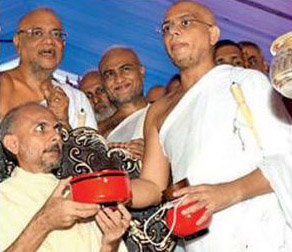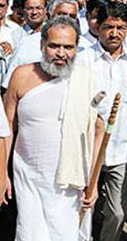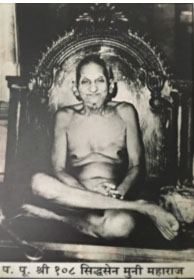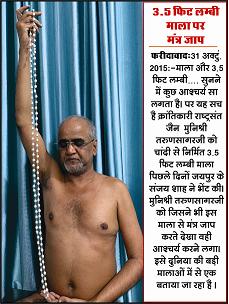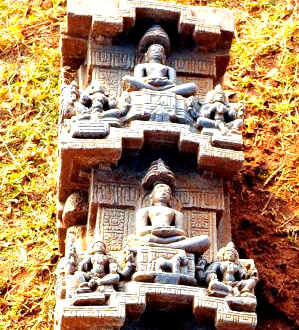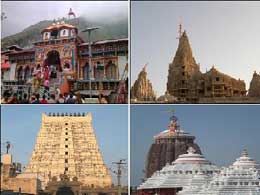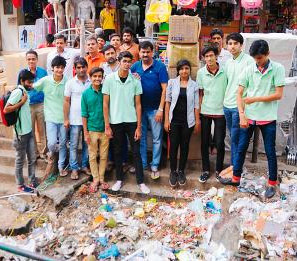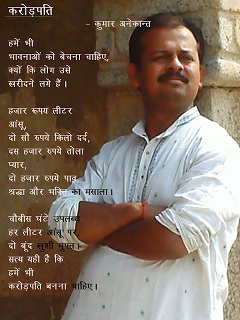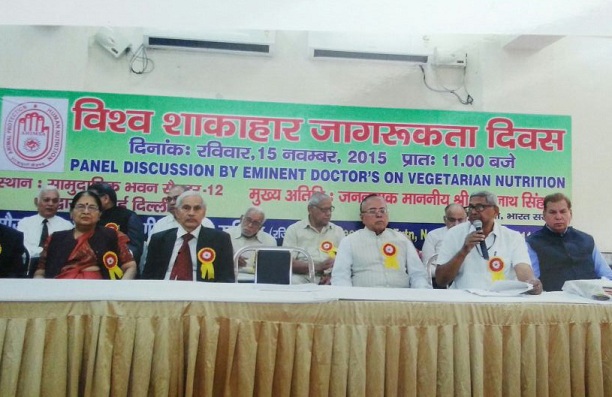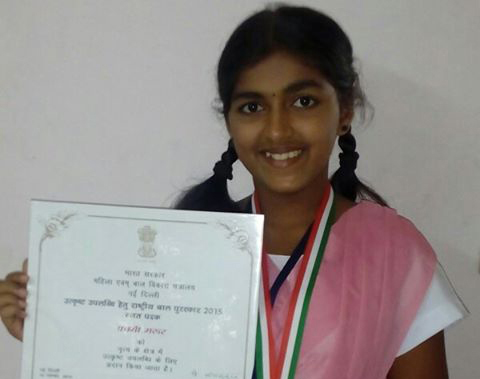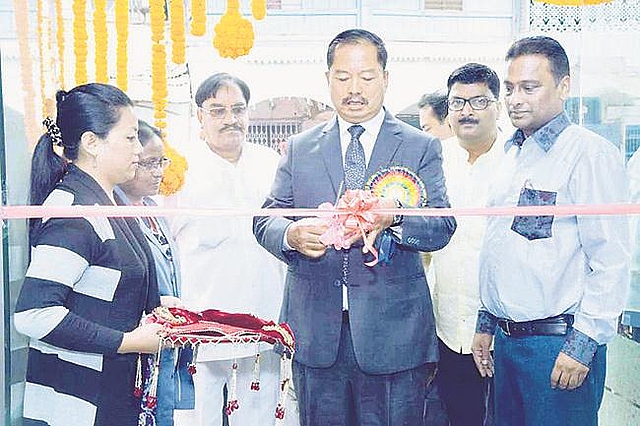|
New Delhi: The ban on the sale of meat for four days during a Jain fasting and a festival called ‘Paryushan’ in Mumbai has now become a national controversy. There are both for and against views on this. According to pro-ban people, without understanding the issue properly and not knowing the history of meat ban in India, some activists are already attacking the BJP government in Maharashtra for this. In reality, several places Hindu and Jain holy places have banned sale of meat across India over the years. In some places meat shops and abattoirs are closed even on Gandhi Jayanthi day (October 2). According to historians Mogul emperor Akbar had banned the sale and use of meat. According to media reports the Brihanmumbai Municipal Corporation agreed for a four-day ban on sale of meat in Mumbai. During Paryushan, Slaughter of animals will not be allowed in Mumbai abattoirs, meat and poultry shops and fish markets will be shut on September 10, 13, 17 and 18 the days of Jain ritual of Paryushan, civic officials said. Restaurants, however, may serve meat, claimed a spokesperson of the Indian Hotels and Restaurants Association. The move came days after the Mira-Bhayander Municipal Municipal Corporation’s controversial decision to ban meat sale for eight days in the city.
The Hindu holy town of Haridwar has banned even the sale of egg in the town. The Supreme Court of India has upheld the ban on even the sale of egg way back in 2004.

According to a report in ‘The Hindu’ dated March 11, 2004 A Bench of Justice Shivaraj V. Patil and Justice D. M. Dharmadhikari of the SC rejected an appeal by Om Prakash and other traders against a judgment of the Allahabad High Court dismissing a writ petition filed by them challenging the notification banning the sale of eggs. The appellants had challenged the ban under an amended provision of the Uttar Pradesh Municipalities Act, 1916 on the ground that it imposed unreasonable restriction, affecting their rights under Article 19(1)(g) of the Constitution. However, the Bench noted that by the amended provision, the Municipal Board had added only "eggs" in the list of already banned non-vegetarian food articles.
"There was already a prohibition in regard to any kind of meat or fish. The High Court has noticed that under the amended provision, the ban on sale of meat and fish, which was existing for a long time, was not challenged." The Bench said the High Court was right in holding that the prohibition on sale of eggs within the limits of Rishikesh a town of Hindu temples was not an unreasonable restriction being in the larger interest of welfare of the people, consistent with the provisions of the Act. Keeping in mind the religious sentiments attached to the three towns of Haridwar, Rishikesh and Muni Ki Reti, the Bench said: "Geographical situation and peculiar culture of the three towns justify complete restriction on trade and public dealing in non-vegetarian food items, including eggs, within the municipal limits of the towns." According to a report in ‘The Times of India’ in 2012, the BJP ruled Palitana municipality in Bhavnagar is following the footsteps of Haridwar. The municipality authorities have banned the sale of eggs and non-vegetarian food in the pilgrim town. The municipality passed a notification banning sale of non-veg food and eggs within the limits of the town in 2012.
The ban was imposed following protests by Jain saints who threatened to self-immolate if the municipality did not adopt the resolution on the lines of Haridwar. Pravinbhai Gadhvi, President of Nagar Palika said that the ban was already there but this was only in the peripheries of the road leading to the Jain temples. Some Jain saints led by Maharaj Saheb Maitriprabhsagar had sat on a fast and later threatened to self-immolate themselves if the Nagar Palika did not ban the sale of non-veg food and eggs within the jurisdiction of the Nagar Palika. Several state governments and local authorities ban the use of meat during some festivals or other holy occasions not to hurt the religious sentiments of devotees and vegetarians.
What is now happening is not new or unprecedented. Then why this unnecessary chattering...Is "MEAT" a new tool in Indian politics...
CELEBRITY STATEMENTS
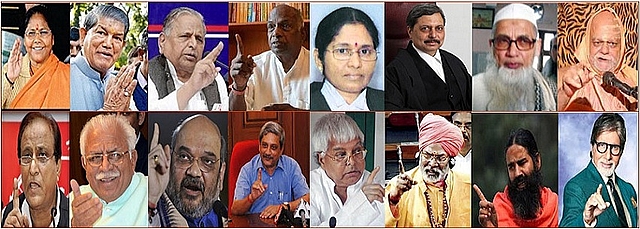 |
Duty of State Govts to Ban Cow Slaughter, says Sadhvi Niranjan Jyoti in Kolkata - “There are a lot of things to eat in this country apart from cow,” Union Minister Sadhvi Niranjan Jyoti said in Kolkata while stressing that it was the “duty” of state governments to ban cow slaughter. Talking about cow slaughter and consumption of beef, Jyoti said, “Such things should not happen. If you are asking for respect from us, then you should also learn to respect us first. “In a democracy it is the duty of the state governments to ban cow slaughter. There are a lot of things to eat in this country apart from cow.”
Harish Rawat, CM Uttarakhand - “I have been dragged into this controversy, I had not spoken a word about it". Hours after media reports quoted Uttarakhand CM Harish Rawat as saying that those who slaughter cows have “no right to live in the country” and are country’s “biggest enemies”, Rawat denied the reports and said he only spoke about cow conservation. The reports had alleged that Rawat made the remark at Gopashtami function in Hardwar.
Mulayam Singh Yadav, "We were first to oppose cow slaughter". Samajwadi Party national president Mulayam Singh Yadav said he would take up the issue of dwindling population of cows with Prime Minister Narendra Modi. He also lauded senior party functionary and UP minister Azam Khan for opposing cow slaughter. He said Khan had worked a lot for the protection of cows and his efforts should be appreciated. Mulayam said every family should breed one cow.
K. N. Govindacharya, former BJP ideologue - ‘Muslims unfairly being blamed for cow slaughter’ Mr. Govindacharya, whose association with the BJP practically ended after his public differences with then Prime Minister Atal Bihari Vajpayee in 1998, said that he was “disturbed by the politicisation of the issue and didn’t want to launch the agitation in such a political atmosphere.” He pointed out that to link the issue of cow slaughter with the Muslim community was wrong as it was the British rather than Muslim rulers of India who promoted cow slaughter. “Cow slaughter came up in a big way after the revolt of 1857, when the British saw this as a way of driving a wedge between the two communities. Under Mughal rule too, cow slaughter used to happen but not on such a huge scale,” he said.
Delhi High Court dismisses plea to ban cow slaughter, sale of beef - The Delhi High Court dismissed a PIL seeking enactment of a law prohibiting the slaughter of cows and the sale of beef and such products across the National Capital Region, terming it as “misconceived”.
Vice-Chancellor Maulana Mufti Abul Qasim Nomani of Darul Uloom, Deoband, one of the largest Islamic seminaries in the country, said that the institution abided by the laws relating to cow slaughter and no such practice was followed at the institution’s headquarters in Uttar Pradesh. ‘Abide by cow slaughter law.’ The Maulana said that in places where there was a ban on cow slaughter, people should abide by it.
Puri Shankaracharya calls for law banning cow slaughter. The seer was in favour of withdrawal of beef from the menu of hotels and boycott of different products made from body parts of cow. Amid the beef row, Puri Shankaracharya Adhokshajanand Tirtha Maharaj called for a central legislation banning cow slaughter even as he was critical of the Delhi police action in Kerala Bhawan in the national capital over a complaint of beef being served there. “Prime Minister (Narendra) Modi should bring a legislation for ban on cow slaughter in the Parliament as well as a ban on export of beef,” Shankaracharya of Goverdhan Peetham Adhokshajanand Maharaj said while talking to reporters. The Shankaracharya was also critical of the way some partners of Union Government were “spreading malice” against a section of society.
Azam Khan: Centre should enact law to check cow slaughter: Uttar Pradesh minister Azam Khan has demanded that the Centre should enact an effective law to check cow slaughter and prevent people from making “irresponsible statements” on the issue of beef and bovines. Khan, in a letter to Shankaracharya of Govardhan Peeth Swami Adhokshjanand Maharaj, thanked him for gifting a cow for his diary and urged him to “talk to Prime Minister Narendra Modi regarding a law to check cow slaughter”.
Chief Minister of Haryana Manohar Lal Khattar warns against cow slaughter. With cow protection law coming into force in Haryana, stringent punishment will be given to those indulging in cow slaughter or selling or eating beef, Chief Minister Manohar Lal Khattar has said. With the notification of the Act on November 19 after the President’s assent, cow slaughter in Haryana will now attract a rigorous imprisonment ranging from three to 10 years. Mr. Khattar said: “The Bill was passed unanimously by all 90 members of the Assembly including three Muslim legislators who hail from Mewat,” a Muslim dominated region.
BJP President Amit Shah asked Bihar Chief Minister Nitish Kumar and Congress Vice President Rahul Gandhi, why they are silent on RJD Chief Lalu Prasad's views on beef and asked them to come out openly whether they endorse it or not. "Why are Nitish Kumar and Rahul Gandhi silent on Lalu Prasad's comment that there is no difference between beef and goat meat... Silence will not do.
Manohar Parrikar at Defence Ministry asks Indian army to stop buffalo slaughter ritual. The Defence Ministry of the Modi government under Manohar Parrikar has asked the Indian army to stop buffalo slaughter. The ministry has asked the army to ensure that none of its units indulge in the ritual slaughtering of buffaloes, which is an age-old tradition. Instructions have been issued to put an end to the practice of certain army units to behead a male buffalo during Dussehra, that is attributed mostly to Gurkha tradition.
RJD Chief Lalu Prasad said, “Poor people eat meat to beat their hunger... Those who go outside (the country) eat beef. Even Hindus eat beef. There is no difference between beef and goat meat." Amid outrage over the lynching of a man in Uttar Pradesh following rumours that he and his family were storing and eating beef, RJD Chief Lalu Prasad stoked a controversy by saying that Hindus also eat beef and accused the BJP of “communalising” the issue.
Sakshi Maharaj - Rahul Gandhi ate beef, visited temple and caused earthquake. Well-known for his controversial remarks, BJP leader Sakshi Maharaj has made heads turn again by stating that Rahul Gandhi's impure visit to Kedarnath has led to the disastrous earthquake in Nepal.
Chief Justice of Jammu and Kashmir High Court constituted a three member bench to address the beef ban issue that had snowballed into a major political controversy in the state.
Baba Ramdev - Eating cow meat "crime". Consuming cow meat in the name of scriptures such as Quran and Bible is an act of crime and amounts to "violence", yoga teacher Ramdev today said, demanding it be declared as the "national animal". Ramdev's remarks come at a time when a controversy has erupted over a Jammu and Kashmir High Court order for enforcement of beef ban in the state.
Amitabh Bachchan - After expressing his ignorance of the BEEF ban LAW, Bachchan quickly added that if such a law had indeed been passed, it should be followed. While Bachchan was perhaps looking to avoid antagonising any section of his fans and followers, people who have watched his career since the 1970s say he has a history of preferring discretion to valour in public and political affairs.
VHP national spokesman Surendra Jain- No problem with meat eaters, but want ban on beef: VHP. Throwing a challenge to writers who are returning their awards, VHP national spokesman Surendra Jain asked if they would go to Saudi Arabia and ask for pork there.
JAIN SAINTS
100TH BIRTH ANNIVERSARY OF SHRI VIKRAMSURISWAR MAHARAJSAHEB CELEBRATED
Mumbai: 23rd November, 2015: The Jain community celebrated 100th birth anniversary of Jain saint Shri Vikramsuriswar Maharajsaheb in Mumbai. The event was organised at Santa Cruz Jain Temple that saw the celebration of late saint organised by his disciple Rajyashsuriswar Maharajsaheb. "As part of the celebration, the community decided to take care of one-year ration expenses of as many as 100 poor Jain families," said Sanjay Shah, member of Jain minorities, who was in-charge of the celebration. The event also saw the presence of prominent BJP leaders like Amit Shah, President of Bharatiya Janata Party, among others. However, Chief minister Devendra Fadnavis, could not reach for other reasons. Amit Shah, who had come all the way from Delhi to attend the function, reached the venue and addressed to community members. He paid hard felt respect to the late saint.
JAIN MONK REWRITES RELIGIOUS HISTORY BY COMPLETING 423 DAYS OF FASTING
|
Mumbai: 2nd November, 2015: It was a religious gathering with a mood of festivity in the air. More than 60,000 Jains thronged the MMRDA grounds in Bandra (East) on a hot Sunday morning where a Jain monk, Hansratnavijayji Maharaj Saheb, created history by breaking 423 days of fasting done over a period of 494 days.
Jain gurus said that such a feat has been achieved after 2,500 years. Beneath a huge canopy put up on the ground, a sea of Jain families had come together to witness the monk, Hansratnavijayji Maharaj Saheb take his first sip and morsel after the long fast. Such fasting is a form of penance called 'Gunaratna Samvatsar Tap'. Chief Minister Devendra Fadnavis also attended the event and sought blessings from the monk. The sponsors of the religious event, a family from Nashik, presented a cheque of Rs51 lakh for drought relief.
Usually, such a religious practice involves 407 fasts over 480 days. Seated on a ceremonial throne bedecked with flowers, two swan figurines flanking the seat, Hansratnavijayji Maharaj Saheb was given a sip of juice and some solid food to break the fast. The crowd of devotees gathered at the venue sent up a collective cheer as the 49-year-old monk broke his fast, as music was being played in the background. The monk had fasted for 108 days a couple of years ago. "The idea behind fasting was to purify the soul and attain internal peace. It was to ensure that good things prevail in life,"said Shree Hansratnavijayiji Maharaj Saheb. A Jain guru, who was at the venue, said that five sadhus had completed such a fast during the time of Lord Mahavir. This form of fasting is considered to be the highest form of penance in Jainism.
COURT REFUSES TO CANCEL WARRANT AGAINST JAIN SAINT
Ahmedabad: Nov 22, 2015: Acharya Kirti Yashurishwarji Maharaj the Jain saint who sought eight months' time to walk to the city from Kolkata to face criminal trial for the publication of a forged government notification in support of Bal Diksha, got a setback on 21st November, 2015 when a city sessions court rejected his plea to quash the warrant against him.
|
He approached the sessions court against the bailable warrant issued against him last month by a metropolitan court because he failed to appear in court for criminal proceedings underway against six persons in all.
However, additional sessions judge P T Patel refused to junk the warrant and allowed the lower court to go ahead with the trial on a day-today basis as directed earlier by the Gujarat high court.
On the other hand, the metropolitan court is to hear an application filed by the complainant urging it to issue a non-bailable warrant against the religious preacher for his failure to respond to two bailable warrants or to appear before the court. The saint argued that he should be granted eight months' time to walk the 2,200 km to Ahmedabad because the use of vehicle is proscribed for him.
Earlier this month, the complainant's advocate moved the HC for protection following undue harassment from supporters of the Jain saintmonk. While granting him police protection, the court expressed surprised at the unprecedented and unreasonable request for such a long adjournment.
It observed, "Whoever may be the person, he should not forget that he is an accused in a criminal case. He is obliged by law to remain present before the trial court. If the accused persons do not remain present, then it is open for the trial court to take appropriate steps in accordance with law to secure their presence by a bailable warrant or a non-bailable warrant."
A metropolitan court has kept its order reserved on application seeking non-bailable warrant (NBW) against a Jain monk in connection with Bal Diksha case.
Complainant's lawyer said that the court completed hearing on their plea for NBW against Acharya Kirti Yashurishwarji Maharaj, who is accused of publishing a forged government notification supporting the practice of Bal Diksha, luring and forcing children to renounce the world in the Jain religion. The court had earlier refused to issue NBW, but the complainant requested for issuance of NBW again after Gujarat high court said that the Jain monk's request for long adjournment was improper and that the court should issue warrant, either bailable or non-bailable, to secure his presence.
SHRI SIDDHASEN SHRUT SAMVARDHAN - THE MLA WHO BECAME A JAIN MONK
Pujya Muniraj Shri 108 Siddhasen Swami established a strong foundation of Jain Dharma in our lives that continues to inspire us today. Fittingly, this organization is proud to bear his name and carry on the work in the honor of his legacy. He was the epitome of courage, detachment, and knowledge. He lived a privileged life as a householder, ascending to the Member of Legislature Assembly (MLA) of the State of Karnataka from the year 1957 to 1962. He had a promising career in politics, if he had wished so, but instead, he renounced all his possessions, family, estate, and became a sky clad Digambara monk. He chose to walk on the true path shown by the Jina, to seek self-purification and ultimately, moksa.
|
Before he was a monk: Shri Siddhasen Muniraj’s birth name was Shriman Balwant Govind Khot. He was born on February 10, 1902 in a small town of Chikkodi, Belgaum District, in the State of Karnataka. He was the eldest of three boys in the Khot family. Balwant Khot was known as a scholar and intellectual having mastered the authority over 10 languages, including Sanskrit, Prakrit, English, Marathi, Hindi, Gujrati, Kannada, Modi, etc. Besides Jain Dharma, he was a keen student of cosmology, horoscope reading, and a master of murti consecration practices, among other things. He also took part in India’s freedom struggle by participating in “Chodo Bharat” (Quit India) movement of 1942.
Turning Point: Shri Balwant Khot attended lectures given by Muni Shri Payasagar Maharaj, one of the chief disciples of Charitrya Chakravarti Acharya Shri Santisagar Maharaj, during the temporary ascetic sojourn (chaturmas) in the year 1935. Over the course of next 4 months, the life of Balwant Khot would completely change for good. He became an ardent follower of Jain Dharma and began critical analysis and study of Jain scriptures and slowly over the years, began practicing detachment. This would continue until all his life finally culminating into ever-pious Jain sainthood (Pravajya), a natural state of accepting major vows, renouncing all possessions, including the clothes, and accepting all directions to be his clothes forever… in pursuit of self-purification, to eliminate attachment and aversion, to destroy karmas….and to seek Moksa.
As a member of Karnataka state legislature: Contrary to his desire, Balwant Khot was forced by his friends and well-wishers to run an election campaign against a formidable political candidate of the region. He won a close election as an Independent candidate, a testament to his clean image as a man of strong integrity. As an MLA, Balwant Khot remained active in trying to improve the young democratic set-up in India by advocating for an efficient, effective, scaled-down government that was within the reach of an ordinary man. Having been disenchanted with the political and governmental machinery that was mired into self-aggrandizement, he authored an English book titled “Abolish State Legislature”, in which he called for a ground breaking reform of the state run governmental system. He advocated radical idea to dissolve the state-based legislature in favor of administering the country in four zones. He believed this would help reduce corruption, inefficiency, red tape, ineffective governance, and at the same time, forge a better integration of people as ‘citizens of one united India’, rather than the identification based on state-specific history and language. He called for emotional, psychological and cultural integration of India to be a prerequisite to become a great nation. He believed such integration will quell demands for separate states, which was an important issue then, and remains still today, a thorny issue.
In his own words, “Democracy need not necessarily mean a vast concourse of people being governed by a correspondingly large number. The peoples’ chosen leaders can be few, whose public life should be free from all blemish.” He argued that democracy works best when its citizenry is educated and informed, and that candidates contesting elections must meet minimum educational requirements. He also believed that voting rights based on ‘adult franchise’ was not suitable at that stage in young independent India, where illiteracy was order of the day. He believed that ignorant masses were not in a position to make an informed decision to elect responsible leaders, who will guide the destiny of the nation. During Balwant Khot’s tenure as MLA, Mr. B. D. Jatti was the chief minister of Karnataka who later on became the Vice President of India. Mr. Jatti was drawn and impressed by the intellectual scholarship of Balwant Khot and the two became very good friends. Mr. Jatti, a Congress party leader, tried to persuade him on a number of occasions to join the Congress party by offering him the Education Ministry. Balwant Khot declined the offer as he thought the acceptance would tantamount to breach of trust placed in him as an independent candidate from his constituents.
He rejected government quarters and all the amenities given to an MLA at the time and chose to live in a small rented room while following all the austere Jain code of conduct. He represented his constituents for a term of 5 years, and while returning back from Mysore, donated his earnings to a Jain temple (Stavanidhi, Belgaum District) and came home literally empty-handed. This was the effect of Jain philosophy on him. Jain ascetic trotting the path of moka: Balwant Khot made number of attempts to take diksa beforehand, but was forbidden by his mother’s deep love for him. He did not want to go against his mother’s wishes, so he remained a layperson for many years practicing strict Jain code of conduct at home and performing study of Jain scriptures. He was also counseled by none other than Charitrya Chakravarti Acharya Shri Santisagar Muni himself not to go against the wishes of his mother. The destiny of sainthood had not dawned upon him yet. On the auspicious day of December 4, 1969, Shri Balwant Khot became a Digabara saint by name of Siddhasen Muni on the foothills of Siddhaksetra Shri Kunthalagiri in southern Maharashtra. His diksa guru was Shri Adisagar Maharaj of Shedabal from the lineage of Acharya Shri Santisagar Muni sangh. The land of Kunthalgirī is pious because two Jain ascetics by name of Shri Kulbhusan and Shri Desabhusan attained salvation in the 4th time cycle of the current Avasarpini Kala (Time of Descent).
Shri Siddhasen Muni travelled extensively in the state of Maharashtra, notably in Baramati, Phaltan, Aurangabad, Nagapur, Solapur areas. He remained engaged in the study of scriptures and followed a strict code of conduct prescribed for the Digambara tradition monks. He did not create his own sangh or followers, but remained a solitary saint in search of truth, self-attainment and self-purification. His dedication to Jain sastra was so deep that he presided over the 54th all India conference of Jain scholars held in Phaltan, Maharashtra State from December 29, 1976 through January 3, 1977. He authored “Achar Dharma”, a book in Marathi language that describes the code of conduct laid down for Jain saints and laypersons. He also wrote on Jain geography, “Trikola Mattu Chandragraha” (Three Regions and the Moon), a book in Kannada language, expounding on structure of the universe as stated in the Jain scriptures. In his 10 years of sainthood, Shri Siddhasen Munī was a vigilant scholar Jain monk who walked the path of rational perception, rational knowledge and rational conduct. His samadhi marana occurred in a small village of Motha Akadiya, Amareli district, in the State of Gujarat on April 30, 1979. Our grateful homage at the feet of Shri Siddhasen Swami:
हरियाणा-पंजाब विधानसभा में होंगे कड़वे-प्रवचन
|
फरीदाबाद: 26 अक्टुं.2015: हरियाणा-पंजाब विधानसभा के संयुक्त सत्र में गूंजेगे जैन मुनि श्री तरुणसागरजी के कड़वे-प्रवचन। उपर्युक्त घोशणा हरियाणा के षिक्षा मंत्री रामविलास षर्मा ने की।
शर्मा ने बताया कि मुनिश्री तरुणसागरजी के चंडीगढ़ आगमन पर हरियाणा सरकार के द्वारा स्वागत किया जायेगा। षिक्षा मंत्री ने मुनिश्री से दोनो विधानसभाओं को सम्बोधित करने का आग्रह किया, जिसे उन्होंने स्वीकृत कर लिया। मुनिश्री तरुणसागरजी इस समय फरीदाबाद में चातुर्मास प्रवास पर हैं।
3.5 फिट लम्बी माला पर मंत्र जाप: फरीदाबाद: 31 अक्टं. 2015-माला और 3.5 फिट लम्बी.... सुनने में कुछ आष्चर्य सा लगता है। पर यह सच है क्रांतिकारी राश्ट्रसंत जैन मुनिश्री तरुणसागरजी को चांदी से निर्मित 3.5 फिट लम्बी माला पिछले दिनों जयपुर के संजय शाह ने भेंट की। मुनिश्री तरुणसागरजी को जिसने भी इस माला से मंत्र जाप करते देखा वही आष्चर्य करने लगा। इसे दुनिया की बड़ी मालाओं में से एक बताया जा रहा है। Source: Br. Satish Bramhchari, Telephone: +91 88 75 101210, E-Mail:
JAIN TEMPLE
800-YEAR-OLD JAIN INSCRIPTION DISCOVERED CLOSE TO MANDYA
|
Bangalore: 1st November, 2015: In an ongoing scientific clearance (exposing remnants with historical significance) at the Archeological Survey of India protected site near Mandya, an inscription dating back to the 10th-12th centuries AD and tracing its roots to the Hoysala regime has been found, which will be a clincher for researchers of Jainism.
The inscription talks about the then ruler giving a village in donation to promote Jainism in the area. The inscription, which was found, has been preliminarily deciphered by epigraphists from Mysuru and will give a lot of fodder for researchers who are trying to establish that this village which was originally called Tippur is older than Sharavanabelagola, a holy centre for Jains. Tippur was earlier ruled by the Gangas between 800 AD and 1000 AD and subsequently by the Hoysalas.
Now called Arattipura, the village has a 250-acre protected site coming under Bangalore Circle of ASI, with remnants of Jainism. It has two small hillocks - Shravana betta and Chikka betta - on which is a small pond and on the site lays scattered loose sculptures. Last year, when a small area of the hillock was exposed, the ASI team found the base of a temple consisting of garbhagriha, arthamantapa, pillared mantapa, yaksha, yakshi and headless tirthankaras. The exercise continued and on October 5, the team exposed another set of five temple complexes with two phases of constructions of brick and stones.
According to the ASI Bangalore the basement of the brick temples were plastered with lime and various shapes of lime bricks were used for construction. The stone platforms were topped with sockets for installing pillars. Along with other remnants, the first Tirthankara, Adinatha was also exposed during the course, which may date back to Hoysala period.
MISCELLANEOUS NEWS ITEMS
TIRATH YATRA YOJANA: JAINS ALLEGE BIASED APPROACH BY PUNJAB GOVERNMENT
Amritsar: 26th November, 2015: National body of the Jain community, Shri All India Shwetamber Sthanakwasi Jain Conference, has alleged that the SAD-BJP coalition government was using partisan approach in the implementation of Chief Minister Tirath Yatra (pilgrimage) Yojana, announced recently.
|
Amrit Lal Jain of the Jain Conference said the state cabinet while approving the plan ignored a minority religion like Jain since they do not form a formidable vote bank. He said the state was sponsoring Sikhs, Hindus and Muslims to undertake pilgrimage to their holy places across the country, but the Jain community was not included. He said Jains as a separate religious entity had been accepted by the state and Union governments yet this treatment was meted out to them. He added that the Jain community had contributed immensely in the industrial, trade and business development in Punjab.
He said they were contributing maximum VAT and other taxes for the development of the state. Besides, Jains were running highest number of charitable hospitals, schools and other social welfare institutes, he added. He said a majority of beneficiaries of these charitable projects were non-Jains. He reasoned that personally he did not like the government sponsoring people to undertake pilgrimages. However, the government was supporting followers of several faiths then why to ignore Jain Community.
YOUNG JAINS ON A CLEAN-UP MISSION IN BANGALORE
Bangalore: 31st October, 2015: Instead of waiting for government agencies, a group of 30 youngsters from the Jain community has taken a vow to do their bit to keep their city clean. The group, called Jainsters, has started a month-long project in which they are conducting a door-to-door waste management campaign and cleaning the garbage in Chickpet and roads in adjoining areas.
|
The group initiated the clean-up drive and has been reaching out close to 5,000 traders in and around the business area of Chickpet, Mamulpet, Nagarathpet, Avenue Road and BVK Iyengar Road to keep their premises clean. The team members of Jainsters are all set to clean more than 60 tonnes of waste that is generated every day on these busy streets.
One of the team members, Ajit Jain, 19, first-year B.Com student of Seshadrupiram College said, "We have been covering all the streets from the past one week to figure out the places where garbage is dumped. Even photographs of these places have been collected so that we can plan to clean the mess accordingly. There is heaps of garbage thrown in front of Mamulpet school and students find it disgusting to get inside after crossing the filth surrounded by rotting waste." "We are working on the cleanliness drive every Sunday, not only in these areas but in different parts of the city as well. There should be serious action taken by the civic agency to curb the waste in our city. The officials concerned should come up with ideas relating to waste management before the city turns into a dump yard," said Ajit.
"There is a drinking water centre provided by our community but due to the amount of garbage dumped in front of the water tank, people are not able to access it," said Vishal Jain, 21, another team member. The group also went around telling shop owners to keep dustbins. "But a lot of them showed us the dustbins they already had and pointed out that customers instead chose to throw waste on the roads. We suggested that the shopkeepers clean the area around their shops instead of waiting for BBMP pourakarmikas. Also, the traders said they will join us in our cleanliness drive," said Aditi Jain, final-year B.Com student of Mount Carmel College.
However, the group felt that just one Sunday would not be enough to do justice to the campaign. Hence they have stretched their cleaning project over four weeks in which they will spend three Sundays clearing the mess. In between, they will conduct a door-to-door campaign to spread awareness on the importance of waste segregation and management.
कैसे बढ़ेगी जैनों की घटती जनसँख्या? डॉ. अनेकांत कुमार जैन
भारत में जैनों की जनसँख्या की विकास दर नगण्य रूप से सामने आ रही है| यह एक चिंता का विषय है |इस विषय पर सबसे पहले हम कुछ प्राचीन आंकड़ों पर विचार करें| तात्या साहब के. चोपड़े की मराठी भाषा में एक महत्वपूर्ण पुस्तक है ‘जैन आणि हिन्दू’, इस पुस्तक के पृष्ठ 47-48 पर कुछ चौकाने वाले तथ्य लिखे हैं जिसका उल्लेख आचार्य विद्यानंद मुनिराज की महत्वपूर्ण पुस्तक ‘महात्मा गांधी और जैन धर्म’ में है –
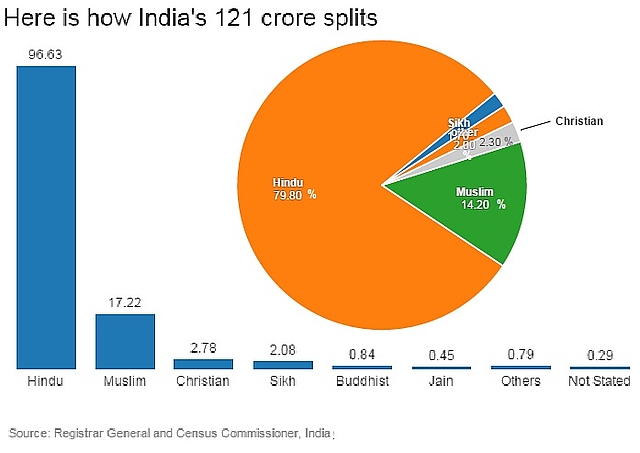
1. ईसा के 1000 साल पहले 40 करोड़ जैन थे।
2. ईसा के 500-600 साल पहले 25 करोड़ जैन थे।
3. ईश्वी 815 में सम्राट अमोघवर्ष के काल में 20 करोड़ जैन थे।
4. ईश्वी 1173 में महाराजा कुमारपाल के काल में 12 करोड़ जैन थे।
5. ईश्वी 1556 अकबर के काल में 4 करोड़ जैन थे।
यदि इन आंकड़ो को सही माना जाय तो यह अत्यधिक चिंता का विषय है कि अकबर के काल से 2500 वर्ष पहले जैन 40 करोड़ थी और उसके समय तक यह संख्या 90 % की कमी के बाद महज 10% बची।
इसके बाद अब कुछ नए आंकड़ों पर विचार करें| साल 2001 के आंकड़ों के अनुसार भारत की कुल आबादी 102 करोड़ थी जिसमें हिंदुओं की आबादी (82.75 करोड़ (80.45 प्रतिशत) और मुस्लिम आबादी 13.8 करोड़ (13.4प्रतिशत थी। इसी जनगणना के अनुसार भारत में जैन धर्म के लोगों की संख्या 4,225,053 थी जबकि उस समय भारत की कुल जनसंख्या 1,028,610,328 थी। 100,000 से अधिक जैन जनसंख्या वाले राज्य जनसंख्या राज्य एवं क्षेत्र में निम्नानुसार थी:
राज्य में जैन जनसंख्या
महाराष्ट्र 1,301,900 1.32%
राजस्थान 650,493 1.15%
मध्य प्रदेश 545,448 0.91%
गुजरात 525,306 1.03%
कर्नाटक 412,654 0.74%
उत्तर प्रदेश 207,111 0.12%
दिल्ली 155,122 1.12%
यह सम्भव है कि जैन लोगों की कुल संख्या जनगणना के आँकड़ों से मामूली मात्र में अधिक हो सकती है।
अभी 2015 में जारी 2011 की जनगणना के अनुसार जैनों की जनसंख्या 44,51,753 हैं जिनमें 51.1 फीसदी पुरुष एवं 48.8 महिलाएं हैं। धर्म आधारित जनगणना से संबंधित मुख्य तथ्य निम्नलिखित रूप से सामने आये हैं -
• हिंदुओं की कुल आबादी 96.63 करोड़ यानी 79.8 फीसदी.
• मुस्लिमों की कुल आबादी 17.22 करोड़ यानी 14.2 फीसदी.
• ईसाइयों की कुल आबादी 2.78 करोड़ यानी 2.3 फीसदी.
• सिखों की कुल आबादी 2.08 करोड़ यानी 1.7 फीसदी.
• बौद्धों की कुल आबादी 84 लाख यानी 0.7 फीसदी.
• जैनों की कुल आबादी 45 लाख यानी 0.4 फीसदी.
जनसंख्या के आंकड़ों के अनुसार 2001 से 2011 के बीच मुस्लिम आबादी में बढ़ोतरी हुई और हिंदू जनसंख्या घटी। सिख समुदाय की आबादी में 0.2% बिंदु (पीपी) की कमी आई और बौद्ध जनसंख्या 0.1 पीपी कम हुई। ईसाइयों और जैन समुदाय की जनसंख्या में कोई महत्वपूर्ण बदलाव नहीं हुआ।
जनगणना के धर्म आधारित ताजा आंकड़ों के अनुसार 2001 से 2011 के बीच 10 साल की अवधि में मुस्लिम समुदाय की आबादी में 0.8 प्रतिशत का इजाफा हुआ है और यह 13.8 करोड़ से 17.22 करोड़ हो गयी, वहीं हिंदू जनसंख्या में 0.7 प्रतिशत की गिरावट दर्ज की गयी और इस अवधि में यह 96.63 करोड़ हो गयी। सिखों की जनसंख्या में 0.2%, बौद्ध जनसंख्या में 0.1% की कमी दर्ज की गई है जबकि इस दौरान मुस्लिमों की जनसंख्या 0.8 प्रतिशत बढ़ी है। ईसाई और जैन समुदाय की जनसंख्या में कोई महत्वपूर्ण बदलाव नजर नहीं आया है। वर्ष 2001 से 2011 के दौरान हिंदुओं की जनसंख्या वृद्धि दर 16.8%, मुस्लिमों की जनसंख्या 24.6%, ईसाई की जनसंख्या 15.5%, सिख की जनसंख्या 8.4%, बौद्ध की जनसंख्या 6.1 और जैन की जनसंख्या 5.4% रही है।
2001 की तुलना में 2011 में जहाँ एक तरफ देश की आबादी लगभग बीस करोड़ बढ़ गयी है वहीँ जैनों की संख्या महज बाईस लाख (226700) के लगभग ही बढ़ी है। मैं भारत सरकार द्वारा जारी इन आंकड़ों को सही मानता हुआ कुछ अपने मन की बात आप सभी के समक्ष रखना चाहता हूँ। आज हमें इस विषय पर गंभीरता से विचार करना ही होगा कि जैन समुदाय की वृद्धि दर सबसे कम क्यूँ रही? यह निश्चित रूप से हमारे अस्तित्व के लिए महत्वपूर्ण चुनौती है। अब इस विषय पर किसी सरकार पर आरोप लगा कर तो हम निश्चिन्त हो नहीं सकते क्यूँ कि इसकी जिम्मेवारी पूरी हमारी है। राष्ट्र की नज़र में इसे जैनों का बहुत बड़ा योगदान भी माना जा सकता है कि जनसँख्या विस्फोट में जैनों की भागीदारी न के बराबर रही। लेकिन जिस प्रकार किसी जीव की प्रजाति लुप्त होने का खतरा देख कर उसके संरक्षण का उपाय, संवर्धन के तरीकों पर विचार किया जाने लगता है उसी प्रकार इस देश की मूल श्रमण जैन संस्कृति के अनुयायियों की जनसँख्या यदि इसी प्रकार कम होती रही और भारत की कुल आबादी का एक प्रतिशत भाग भी हम हासिल न कर सके तो भविष्य में जैन कहानियों में भी सुरक्षित रह जाएँ तो गनीमत माननी पड़ेगी।
जैनों की घटती आबादी का प्रमुख कारण-
आम तौर पर जब इस बात की चिंता की जाती है तो एक सरसरी निगाह से जैनों की घटती आबादी के निम्नलिखित प्रमुख कारण समझ में आते हैं-
1. परिवार नियोजन के प्रति अत्यधिक सजगता।
2. शिक्षा का विकास, 94% साक्षरता की दर।
3. ब्रह्मचर्य व्रत के प्रति गलत धारणा।
4. प्रेम विवाह के कारण जैन परिवार की कन्याओं का अन्य धर्म परिवारों में विवाह।
5. सधर्मी भाइयों के प्रति तिरस्कार की बढती प्रवृत्ति।
6. पंथवाद और जातिवाद की कट्टरता।
7. विभिन्न रोगों के कारण बढती मृत्यु दर।
8. दूसरों को जैन बनानें की प्रवृत्ति या घर वापसी जैसे आंदोलनों का अभाव, आदि आदि।
जैनों की आबादी बढाने के लिए कुछ प्रमुख उपाय –
|
जैन समुदाय को भारत की कुल आबादी का एक प्रतिशत भाग हासिल करने के लिए अवश्य ही एक मुहिम चलानी होगी। और इस कार्य में स्वतः ही प्रेरित होना होगा, इसे एक सामाजिक आन्दोलन बनाना होगा। इसके लिए हमें कुछ समाधान की तरफ आगे बढ़ना होगा। वे समाधान निम्नलिखित प्रकार से हो सकते हैं–
1. परिवार को समृद्ध बनायें - संपन्न तथा संस्कारी परिवारों को परिवार नियोजन के प्रति थोड़ी उदासीनता रखनी चाहिए। हम दो हमारे एक की अवधारणा को छोड़ कर कम से कम हम ‘हम दो हमारे दो’, या तीन का नारा तो देना ही होगा, हमारे चार या पांच भी हों तो भी बहुत अधिक समस्या नहीं होगी। यदि हमारे पास आर्थिक सम्पन्नता है और पर्याप्त संसाधन हैं और किसी कारण से बच्चे नहीं हैं या हो नहीं रहे हैं तो हमें अनाथालय से बच्चे गोद लेने में भी संकोच नहीं करना चाहिए। यदि बच्चे पहले से हैं किन्तु कम हैं तो भी उन बच्चों के कल्याण के लिए तथा अपने धर्म की रक्षा के लिए भी गोद लेने की प्रवृत्ति को विकसित करना चाहिए। इससे वे बच्चे जन्म से संस्कारी तथा जैन बनेंगे। समृद्धि का अर्थ सिर्फ धनादि अचेतन वस्तुओं का भण्डार नहीं होता, बल्कि चैतन्य बच्चों की चहल पहल भी उसका एक दूसरा महत्वपूर्ण अर्थ है।
2. बड़े परिवार का करें अभिनन्दन-समाज को अब उन माता पिताओं को सार्वजनिक समारोहों में अभिनन्दन कर पुरस्कृत भी करना प्रारंभ करना चाहिए जिन्होंने अधिक संतानें जन्मीं हैं। यह कार्यक्रम एक प्रेरणा का काम करेगा। एक सरकारी नारा बहुत प्रसिद्ध हुआ “छोटा परिवार, सुखी परिवार”, जैन समाज ने इस फार्मूले को बहुत अपनाया। इस नारे का पूरक भाव यह ध्वनित हुआ कि ‘बड़ा परिवार दुखी परिवार’, इन सिद्धांतों के पीछे आर्थिक और सामाजिक कारण मुख्य थे। कमाने वाला एक होगा और खाने वाले अधिक तो दुखी परिवार होगा और खाने वाले कम होंगे तो परिवार सुखी होगा। किन्तु गहरे में जाकर देखें तो ऐसी स्थिति नहीं है। संतोष, सादगी, सहिष्णुता, त्याग, प्रेम, अनासक्ति आदि आध्यात्मिक मूल्यों के अभाव में छोटे परिवार भी दुखी रहते हैं और जहाँ ये मूल्य हैं वहां बड़ा परिवार भी सुखी रहता है। सुख और समृद्धि को एक मात्र आर्थिक आधार पर निर्धारित करना बेमानी है। नारा होना चाहिए ‘आध्यात्मिक परिवार सुखी परिवार।
3. ब्रह्मचर्य अणुव्रत के प्रति गलत अवधारणा–अक्सर लोग कम जनसँख्या के पीछे तुरंत ही ब्रह्मचर्य अणुव्रत को दोष देने लग जाते हैं। यह छोटी और तुच्छ सोच है। गृहस्थ को संतान उत्पत्ति के उद्देश्य से की जाने वाली मैथुन क्रिया का कभी भी धर्म शास्त्रों ने निषेध नहीं किया। श्रावक धर्म प्रदीप का एक श्लोक है–
विहाय यश्चान्यकलत्रमात्रं सुपुत्रहेतोः स्वकलत्र एव।
करोति रात्रौ समयेन सङ्गं ब्रह्मव्रतं तस्य किलैकदेशम्। श्लोक-178
आप गहराई से विचार करें तो पाएंगे कि जब तक गृहस्थों के जीवन में ब्रह्मचर्य अणुव्रत की अधिकता रही है तब तक बच्चों की संख्या अधिक रही। आज इस व्रत का अभाव है और संतानें कम हो रही हैं। कोई अनाड़ी होगा जो ये कहेगा कि आज बच्चे इसलिए कम हो रहे हैं क्यूँ कि घरों में ब्रह्मचर्य है। राजा ऋषभदेव के सौ पुत्र थे जब कि पत्नी केवल दो थीं। आज की पीढ़ी जब अपने ही बुजुर्गों के 10-15 बच्चों की बातें सुनती है तो मजाक में सहज ही कह उठती है कि उन्हें और कोई काम नहीं था क्या? जब कि साथ ही यह भी सच है कि उन्होंने उन्हें कभी सतत रोमांस करते नहीं देखा। आज रोमांस तो खुले में सड़कों पर उन्मुक्त है किन्तु उसमें संतानोत्पत्ति का पावन उद्देश्य नहीं है, बल्कि इसके स्थान पर मात्र भोग और वासना है। बच्चे पैदा करना और उनका लालन पालन करना एक तपस्या है जो भोगी नहीं कर सकते और करते भी नहीं हैं। यह काम भी ब्रह्मचर्य अणुव्रत के महत्व को समझने वाले योगी ही करते हैं। इसलिए ‘बच्चा माने अब्रह्मचर्य’-यह अवधारणा जितनी जल्दी सुधर जाए उतना अच्छा है। यह कतई नहीं कहा जाता कि जो कपल बच्चा प्लान नहीं करता वह ब्रह्मचर्य का संवाहक हैं।
4. प्रेम विवाह की समस्या को समझें- प्रेम विवाह के प्रति आज भी हमारा नज़रिया दकियानूसी है। हम अपनी समाज में आवश्यकता अनुसार कोई अवसर प्रदान नहीं करते और बाद में रोते हैं। प्रेम विवाह आज की आवश्यकता बन चुका है, इसे रोकने की बजाय इसे नयी आकृति दीजिये। काफी हद तक समाधान प्राप्त हो सकता है।
हमारी बेटियां जो अन्य धर्म के लड़कों के साथ प्रेम विवाह कर रही हैं इसके लिए हमे अपनी समाज में एक तरफ तो संस्कारों को मजबूत बनाना होगा दूसरी तरफ समाज में खुला माहौल भी रखना होगा। सामाजिक संस्थाओं में अनेक युवा क्लब ऐसे भी बनाने होंगे जहाँ जैन युवक युवती आपस में खुल कर विचारों का आदान प्रदान कर सकें, एक दुसरे के प्रोफ्फेशन को जान सकें और अपनी ही समाज में अपने प्रोफेशन और भावना के अनुरूप जीवन साथी खोज सकें। समाज में अनेक कार्यक्रम तो होते हैं किन्तु वे धार्मिक किस्म के ही होते हैं और वहां जैन युवक युवतियों को साथ में उठना बैठना, वार्तालाप आदि करना भी पाप माना जाता है, तब ऐसी स्थिति में उन्हें स्कूल, कॉलेज, विश्वविद्यालय, ओफिस आदि में अपने अनुरूप जीवन साथी खोजने पड़ते हैं जो किसी भी धर्म के हो सकते हैं। यद्यपि यदि बेटी के संस्कार अत्यंत मजबूत हों तो बेटी अन्य धर्म के परिवार में जाकर युक्ति पूर्वक उन्हें जैन धर्म का अनुयायी बना सकती है और यह जैन समुदाय की संख्या बढ़ने में कारगर हो सकता है लेकिन ऐसा बहुत दुर्लभ और नगण्य है। यदि हम अपने परिवार और बेटे के संस्कारों को बहुत मजबूत रखें तो अन्य धर्म से आई बहु भी जैन धर्म का पालन कर सकती है किन्तु ऐसा बहुत कम देखा जाता है। अधिकांश जैन परिवार एक अजैन बहु के मिथ्यात्व से प्रभावित होकर अजैन होते देखे गए हैं। आज के परिवेश में प्रेम विवाहों को कोई नहीं रोक सकता अतः ऐसे अवसर निर्मित करने होंगे ताकि साधर्मी प्रेम विवाह ज्यादा हों।
5. विवाह में विलम्ब है मुख्य समस्या–हमने विवाह को लेकर इतने जटिल ताने बाने बुन रखे हैं कि उन्हें सुलझाने में बच्चों की उम्र निकल जाती है और उलझने फिर भी समाप्त नहीं होतीं। आज से पचास वर्ष पूर्व और अब में जो विडंबना देखने में आ रही है वह यह कि तब विवाह पहले होता था और जवानी बाद में आती थी आज जवानी बचपन में ही आ जाती है और विवाह अधेड़ उम्र में होता है। मैं बाल विवाह का पक्षधर नहीं हूँ लेकिन उसके भी अपने उज्जवल पक्ष थे जो हम देख नहीं पाए। बाल विवाह के विरोध में जो सबसे मजबूत तर्क यह दिया गया कि Teen age pregnancy लड़की के स्वास्थ्य के लिए ठीक नहीं, बात सही है किन्तु ये समस्या तो आज भी है अंतर बस इतना है कि पहले यह विवाह के अनंतर होती थी और आज विवाह से पूर्व। इस समस्या को थोड़े खुले दिमाग से समझना होगा। आज लड़का हो या लड़की उनका विवाह तभी होता है जब उनका कैरियर बन जाये, पढ़ लिख जाएँ। यह विवाह नहीं समझौता है।
जीवन में जवानी का सावन अपने समय से ही आता है जब किसी भी किशोर या युवा को शारीरिक, मानसिक तथा भावनात्मक रूप से एक जीवन साथी की प्रबल अपेक्षा होती है, जहाँ उसका अधूरापन पूर्ण होता है। वे स्वयं, परिवार या समाज शिक्षा, कैरियर, पैसा, दहेज़ या अन्य अनेक कारणों से उन दिनों विवाह नहीं होने देते तब ऐसे समय में बाह्य कारणों से भले है बाह्य / द्रव्य विवाह न होता हो किन्तु भाव विवाह / इश्क / प्रेम / मुहब्बत.............आदि आवश्यकता के अनुसार गुप्त रूप से संपन्न होने लगते हैं क्यूँ कि प्रकृति अपना स्वभाव समय पर दिखाती है आपकी कृत्रिम व्यवस्था के अनुसार नहीं। बरसात यह सोच कर कभी नहीं रूकती कि अभी छत पर आपके कपड़े सूखे नहीं हैं। फिर हम रोते हैं मेरे बेटे ने दूसरी जात / धर्म की लड़की से शादी कर ली क्यूँ कि वह उसी के साथ अच्छी जाब पर है या मेरी बेटी मोहल्ले के एक अलग धर्म / जात के सुन्दर लड़के के साथ भाग गयी भले ही वह बेरोजगार हो। गलती सिर्फ बच्चों की ही नहीं है माँ-बाप और समाज की भी उतनी ही है। विशेषज्ञों का मानना है कि कोई भी लड़की / महिला यदि तीस वर्ष की उम्र तक एक बार भी माँ नहीं बने तो बाद में उसे माँ बनने में बहुत समस्या होती है अब अगर उसका विवाह ही किसी भी कारण से 29-30 वर्ष में होगा तो समस्या तो आएगी ही।
कहने का मतलब यह है कि इस जटिलता को हम नहीं सुलझाएंगे तो कौन सुलझाएगा? विवाह के बाद की खर्चीली शर्तों को यदि हम थोड़े वर्षों के लिए टाल दें और उच्च शिक्षा आदि को भी विवाह के बाद या साथ साथ करने का सहज वातावरण बनायें तो समस्या काफी कुछ हद तक सुलझ सकती है। जनसँख्या में कमी का ही नहीं सामाजिक स्वास्थ्य बिगड़ने का भी यह एक बहुत बड़ा कारण है। शास्त्रों के अनुसार भी वास्तविक विवाह सिर्फ कन्या का ही होता है, महिलाओं की तो सिर्फ शादी / समझौता होता है।
सेक्स अनुपात में असन्तुलन - जैनसमाज यदि किसी सर्वे एजेंसी से कुछ सर्वे करवा कर वास्तविक आंकड़े इकट्ठे करे तो परिणाम चौंकाने वाले होंगे।मेरा अनुमान है कि 10 लड़कों के मुकाबले 6 लड़कियों का अनुपात हो गया है। किन्तु लड़की पैदा होने पर आज भी क्षोभ होता है और गर्भपात भी हो रहे हैं। लड़कियों के अभाव में भी विवाह नहीं हो पा रहे हैं। बुन्देलखण्ड के कई जैन परिवारों में पैसे खर्च करके ऐजेन्टों के माध्यम से उड़ीसा से कन्याओं को ब्याह कर लाया जा रहा है। सामान्य आय वाले लड़कों को जैन लड़कियाँ मिलना मुश्किल हो गया है। इन विषयों पर हम कुछ नहीं कर पा रहे हैं। ऐसे समय में कन्या वृद्धि के लिए समाज की संस्थाओं को विशाल स्तर पर एक 'ब्राह्मी-सुन्दरी' योजना प्रारम्भ करनी चाहिए जिसमें कन्या के जन्म के साथ ही उसके माता पिता को सम्मानित किया तथा यदि आवश्यकता हो तो उसकी शिक्षा, लालन पालन, चिकित्सा आदि को संस्थान द्वारा पूरा किया जाए।
6. सहिष्णुता का विकास करना होगा- समाज के प्रत्येक व्यक्ति को अपने जैन भाई के प्रति सहिष्णुता, सौहार्द्य और सहयोग की भावना का विकास करना ही होगा ताकि लोग जैन धर्म और समाज का अंग बनने में सुरक्षित और गौरव का अनुभव करें। सामाजिक बहिष्कार की प्रवृत्ति पर अंकुश लगाना होगा। अलग पंथ, जाति आदि के प्रति सह-अस्तित्व का भाव बनाये रखना होगा। एक दूसरे को मिथ्या-दृष्टि कहने की प्रवृत्ति पर लगाम कसनी होगी। हम चाहे परंपरा, धार्मिकता, दार्शनिकता, सांस्कृतिकता, जातीयता के आधार पर कितने ही मतभेद रख लें किन्तु मन-भेद कदापि न रखें, प्रत्येक के प्रति लोकतंत्रात्मक दृष्टिकोण ऐसा अवश्य रखें कि भले ही वह अन्य गुरु या सम्प्रदाय का भक्त है पर है तो जैन ही अतः जैनत्व के नाते भी आस्था और विश्वास के उसके कुछ अपने कुछ स्वतंत्र अधिकार हैं उसे इस अधिकार से वंचित करने वाले हम कौन होते हैं? हमें आचार्य समंतभद्र विरचित रत्नकरंड श्रावकाचार का यह श्लोक हमेशा याद रखना चाहिए–
स्मयेन योन्यानत्येति धर्मस्थानम् गर्विताशयः।
सोत्येति धर्ममात्मीयं न धर्मो धार्मिकैर्विना।श्लोक-26
7. धर्म के नए सदस्य बनाने होंगे-हमने आज तक विशाल स्तर पर कभी ऐसे प्रयास नहीं किये जिससे अन्य लोग भी जैन बनें। कभी अपनी सेवा आदि के माध्यम से ऐसे उपाय करने होंगे कि अन्य धर्म के लोग जैन धर्म के प्रति आकर्षित हों तथा इस धर्म का पालन करें। ऐसे स्कूल आदि विकसित करने होंगे जहाँ रहने, खाने, चिकित्सा आदि की पूर्ण निःशुल्क व्यवस्था हो और जहाँ सभी जाति और समुदाय के हजारों, लाखों बच्चे पढ़ें। वहां उन्हें जैन संस्कार जन्म से दिए जाएँ और उन्हें आचरण, पूजन पाठ आदि के प्रति निष्ठावान बनाया जाय। उन्हें जैन संज्ञा देकर उनके तथा उनके परिवार को हम संस्कारित कर सकते हैं। हमारे यहाँ ऐसे मिशन का अकाल है। आर्य समाज में गुरुकुल में बच्चों को पढ़ाते हैं और बाद में उनके नाम के आगे ‘आर्य’ यह टाईटिल लिखा जाने लगता है। आज जब जैन समाज में कई ऐसे विद्यालय तथा छात्रावास भी अर्थाभाव में बंद होने के कगार पर हैं जहाँ सिर्फ जैन बच्चे पढ़ते हैं और जैनदर्शन पढ़ाया जाता है वहां यह अपेक्षा कैसे की जा सकती है कि अन्य समाज के गरीब बच्चों के लिए वे ये सुविधाएँ दे पाएंगे और यह विशाल मिशन अपने धर्म की वृद्धि के लिए शुरू कर पाएंगे।
सराक जाति की तरह और भी जातियों का अध्ययन करके उन्हें वापस जैन समाज में गर्भित करने की विशाल योजनाएं भी बनानी होंगीं। घर वापसी आन्दोलन चलाना होगा तब जाकर हम जैन समाज का अस्तित्व सुरक्षित कर पाएंगे।
8. न्यूनतम आचार संहिता बनानी होगी - जैन कहलाने के भी कुछ न्यूनतम सामान्य मापदंड बनाये जाएँ जैसे जो णमोकार मंत्र जानता है, मद्य / मांस का त्यागी है और वीतरागी देव शास्त्र गुरु को ही मानता है वह जैन है। हमें कर्मणा जैन की अवधारणा को अधिक विकसित करना होगा।
9. स्वास्थ्य के प्रति सजगता - जैन धर्म के अनुयायियों को अपने स्वास्थ्य पर भी ध्यान देना होगा, भोजन समृद्धि के अनुसार नहीं बल्कि स्वास्थ्य के अनुसार लेने की प्रवृत्ति इस दिशा में सुधार ला सकती है। इससे आयु अधिक होगी और मृत्यु दर कम होगी। जैन योग और ध्यान की अवधारणा का प्रायोगिक विकास करना होगा जो हमें स्वस्थ्य रखेगा और दीर्घ आयु बनाएगा।
10. जैन टाइटल का विस्तार - अपने नाम के आगे “जैन” लगाने की प्रवृत्ति को और अधिक विकसित करना होगा। जैन धर्म का साधारणीकरण भी करना होगा और उसे जन धर्म बनाना होगा। आदि यदि हम इसी प्रकार कुछ और अन्य उपाय भी विकसित करें तो हम अपने एक प्रतिशत के लक्ष्य तक तो पहुँच ही सकते हैं, शेष और अधिक के लिए बाद में अन्य रणनीतियाँ भी बनायेंगे।
Dr. Anekant Kumar Jain, (Awarded by President of India), A. Professor, Deptt. of Jainphilosophy, Sri Lalbahadur Shastri Rashtriya Sanskrit Vidyapeeth, Deemed University Under Ministry of HRD, Govt. of India, Qutab Institutional Area, New Delhi-110016, E-Mail:
AHIMSA, NON VIOLENCE AND VEGETARIANISM
AFTER BEEF, THANE JAINS SEEK BAN ON FIRECRACKERS
Thane: 5th November, 2015: In a move that may not go down well with the majority community, the 50,000-strong Jain community in Thane has appealed to its members to shun firecrackers this Diwali. The move assumes significance as it comes a couple of weeks after the controversy over the ban on beef during the Jain fasting period of Paryushan.
|
In fact, the community elders are pressing for a blanket ban on crackers altogether. The members of the Rajasthani Jain Sangh, one of the oldest associations in the city that runs many Jain temples, has urged the youths and children to celebrate the festival which starts from November 9 - without causing harm to the environment and birds and animals. The Sangh is appealing to the visitors to the 150-year-old Jain temple in Tembhi Naka to say no to crackers. If the youths pay heed to their appeal, the Sangh plans to give away gifts and awards in the form of certificate to them. The members will be spreading a word among their neighbors, friends as well as colleagues with an aim to reach out to maximum people.
Gunwant Salecha, another community member, said, "Diwali can be celebrated without disturbing the environment. It's known as the festival of lights, and we want kids from the community to celebrate it without troubling birds and animals." Members of other communities are not taking too kindly to the initiative of the Jains. In their opinion, "All these years, they never voiced their demands politically or for imposition on everyone. But now, the Jains are becoming increasingly vocal about their demands, even if for seemingly right causes. This is interference and is bound to provoke others."
CONFERENCES, SEMINARS & EVENTS
WORLD VEGETARIAN AWARENESS DAY CELEBRATED
New Delhi: 17th November, 2015: The World Vegan Day is an annual event celebrated on 1st November, by vegans around the world. The World Vegan month is on for the entire month of November. Going vegan means having a completely vegetarian diet while also eliminating milk and dairy products too. It is basically to do with people who do not want to harm animals in any possible way and thus those who practice veganism also try and avoid products made from animal skin or those which have tested on animals. The simplest definition of vegetarianism is a diet that is free of meat and fish. But the eating habits of vegetarians cover a wide spectrum. At one end are lacto-ovo vegetarians who avoid meat but eat eggs and milk products, and at the other end are vegans, who forgo all animal-based products, milk, milk products and honey included.
|
The Animal Welfare Society of India in collaboration with the Federation of CGHS, Dwarka celebrated World Vegetarian Awareness Day. To mark the occasion a function was held on 15th November at 10.30 am at SDMC Community Centre, Sector-12, near Rockland Hospital. The Chief Guest on this occasion was Home Minister, Rajnath Singh. The event was organised to promote the concept of Vegan and benefits of vegetarianism. Various programmes were organised to promote vegetarian food. Large number of residents including members of various social organisations and school children were present. The programme started with lighting of the traditional lamp by guests and Saraswati Vandana. All eminent guests including Satyendra Singh, President of Animal Welfare Society, Dr. H. S. Jain, General Secretary, Dr. D. C. Jain, Patron of Animal Welfare Society, Sudha Sinha, General Secretary of Federation of CGHS, Dwarka, Anil Jain, Ahimsa Foundation were welcomed by garlands.
The organisers also invited renowned panel of doctors to share their experience and knowledge about vegetarianism and its impact on human body. Doctors who participated in panel discussion included Sumita Mittal, Dr. Nirmal Kumar, Dr. Mishra, Dr. Meeta Kumar, Dr. M. M. Bajaj, Dr. A. K. Jain, Dr. Kapil and many more. All panel members emphasized the need to have a healthy eating habit and said that active lifestyle and vegetarian food is the best way to stay healthy.
|
Dr. D. C. Jain, renowned Neuron Physician and former Head of the Department of Neurology at Safdar Jung Hospital and ex- Director General Health Services is the force behind movement of vegetarianism in Delhi. In his keynote address Dr. D. C. Jain, said that though many diseases have been eradicated now like small pox and polio, but other dangerous lifestyle diseases have come up. This is due to faulty diet and eating less of vegetarian food. This can be rectified by being vegan. He said that being vegetarian is to keep a balance and harmony with nature and coexist peacefully with the environment and its other constituents. His address was followed by panel discussion of doctors who stressed on health benefits of going vegan that included reducing weight since a vegan diet has less fat and is low in calories, regulate blood pressure, benefit for those with heart problems, increases immunity and is thus said to reduce cancer risk, is rich in fibre, vitamins and minerals etc. Apart from this, since there are no preservatives in a vegan diet it benefits the skin and leaves you refreshed and it is environment and eco-friendly. Most doctors emphasised that a low-fat diet high in fruits, vegetables and nuts is a boon to health. There is also widespread acknowledgment that reducing or eliminating red meat from the diet cuts the risk of heart disease. A plant-based diet can also improve the health of people with type 2 diabetes, improve overall glycaemic levels (a calculation of the effect of different foods on blood glucose levels) and control lipid levels. A diet based on fruits and vegetables, which are low in calories, will help maintain weight.
Children of Kabool Kanya Inter College, Khatauli presented a wonderful skit based on theme of animal’s call to let them live. In between children of Vandana International School also presented patriotic song. According to organizer Sudha Sinha, General Secretary of Federation of CGHS, Dwarka, “The event was very useful in raising awareness of the citizens towards their eating habits and other aspects such as hygiene and preventing spreading of diseases. Large number of people and RWA members participated and appreciated the programme.” Report by Ms. Sudha Sina, E-Mail:
INTERNATIONAL CONFERENCE - SCIENTIFIC DEVELOPMENT AND OUR RESPONSIBILITY
Under the blessings of Jain Saint Aacharya Shri Gyan Sagarji Maharaj, Gyan Sagar science Foundation is organising on 5th December, the “International Conferences on Scientific Development and our Responsibility” where Scientists from different fields like Physical Sciences, Mathematical Sciences, Chemical Sciences, Biological Sciences, Environmental Sciences, Structural Sciences, Forensic Sciences and Medical Sciences shall participate to share their experiences in their respective fields.
|
So far, the foundation has organized three conferences, first in the year 2010 at Bangalore and second in the year 2012 at Mumbai and 3rd International Conference on Scientific Development and our Responsibility 2014 from 8-9 February 2014 at Convention Centre Mini Vigyan Bhawan, New Delhi. In the Series, the 4th International conference shall be held at Sonagiri Sidha Khshetra in MP. This is the first time that such an event is being organized at Sidha Kshetra in which scientist from various part of the world are participating.
The conference shall propagate ancient scientific knowledge available from 5000 years old literature in different forms to masses. Scientists and other learned speakers will interact with cross functional holistic persons who have deep knowledge of our ancient literature which can act as catalyst in furthering progress of our society. For further information contact: Gyan Sagar Science Foundation, New Delhi, www.gyansagarsciencefoundation.in, E-Mail:
National Conference on Global Warming and Climate Change ADDRESSED BY LOKESH MUNI
Bhopal: 20th November, 2015: National conference on ‘Global Warming and Climate Change- A way out’ organised by Madhya Pradesh Government in Bhopal was attended by several prominent spiritual leaders, political leadership, environmentalist from the country. The names included founder of Art of Living Sri Sri Ravi Shanker, founder of Ahimsa Vishwa Bharti and eminent Jainacharya Acharya Dr. Lokesh Muni, External Affairs Minister of India Mrs. Sushma Swaraj, Chief Minister of Madhya Pradesh Mr. Shivraj Singh Chouhan. Member of Parliament (Rajya Sabha) & Chairman of Conference Organizing Committee Mr Anil Madhav Dave, State Minister for Urban Development and Environment Mr. Lal Singh Arya, Samni Charitr Pragya, Convener of the Conference and Principal Secretary Urban Development and Environment, Government of Madhya Pradesh Mr. Ajatshatru Shrivastava, IAS
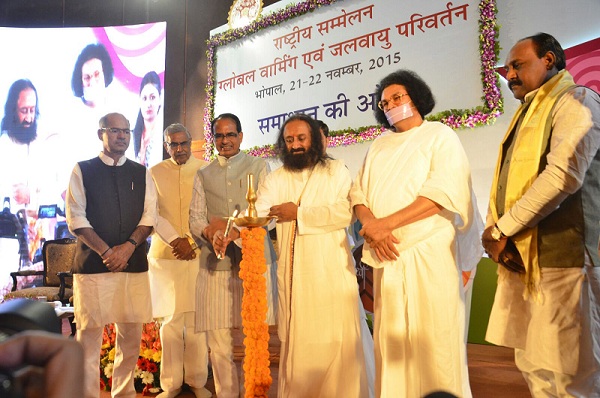
Chief Minister Mr. Shivraj Shingh Chouhan addressing the conference said that environment cannot be protected by spending money but by creating awareness among the people. Natural resources must be loved. He said that India already has awareness for problems like global warming and climate change. India has the ancient culture of worshipping the nature. We have to bring alive the tradition of respecting nature.
Sri Sri Ravi Shanker inaugurating the conference said that the world is faced with the problem of climate change. Glaciers are melting, temperature is rising, the hole is created in Ozone layer this harms the living beings by exposing them to ultraviolet rays from the sun, environment pollution is increasing. To solve these global problems we have to go to its root cause and find the solution for that.
Acharya Lokesh Muni said that selfish activities of humans are responsible for this imbalance in the environment. Nature and religion are the pillars of healthy, happy and comfortable life. When humans subjugated by selfish interest and greed go against nature and religion healthy and happy life is disturbed. Person’s uncontrolled greed and selfish desires leads to rampant cutting of forests, extraction of minerals etc. Extreme materialistic lifestyle is harming the nature. Acharya Lokesh said the 24th Tirthankar of Jain religion Bhagwan Mahavir gave the principal of ‘Shat Jeevnikay’ which means that earth, water, fire, wind, plants all are living. These should not be unnecessarily broken or punctured. They should not be used more than requirement. He said that desires are unlimited but resources are limited. Limited resources cannot fulfil unlimited desires.
JAINA Initiative on Santhara
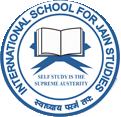 |
International School of Jain Studies is organizing three international seminars on sallekhana / santhara at University of Madras, National Law university Delhi and Teerthanker Mahavira University (Medical School and Hospital) in February, 2016.
Experts on subject from USA Canada and Europe along with leading personalities in India are expected to share and exchange their views. Brochure can be viewed from the link below. Website: www.isjs.in/node/175 Brochure: www.dropbox.com
AWARDS AND HONOURS
PANCHAMI MAROOR GETS AWARD FROM PRESIDENT FOR EXCEPTIONAL ACHIEVEMENT
14th November, 2015: Panchami Maroor from Moodbidri received the 'National Child Award for Exceptional Achievement- 2015' from President Pranab Mukherjee in the presence of union women and child development minister Maneka Gandhi on Saturday, November 14.
Innovation, singing, acting, sports and a gamut of such talents in 30 children from across India got special recognition as President Pranab Mukherjee gave away the national child awards for exceptional achievement, 2015, in a ceremony at Rashtrapati Bhavan. The award winners are aged between nine and 16.
|
Parents of Panchami Parshwanath and Deepasree and her brother Pratham Maroor were also present during the occasion. The award is given by the central women and child development ministry. Panchami is a student of Jain high school in Moodbidri.
Panchami was also chosen for the state award given by state women and child development ministry. The award was given by Governor Vajubhai Vala at Jawaharlal Bhavan at Cubbon Park in Bengaluru. Sudesh Jain Makkimane received the award on Panchami’s behalf.
Achiever in five fields: Panchami, who studies in the eighth standard of Jain High School here, has excelled in Yakshagana, dance, music, sports and educational sectors. In these five fields, she has been incessantly registering one achievement after the other since the last eight years. She is immensely popular among the masses because of his prowess in different art forms, which she has proved with stage shows and television programmes. Already she has presented over 700 programmes including about a hundred shows of 'Yakshagana Nritya Vaibhava'.
Panchami has also come in for lavish praise by taking part in talent hunt programmes of the small screen. In Zee TV Kannada's 'Kuniyona Bara' programme, she won the 'best expression' award, while she annexed 'Muddina Putani' award by taking part in 'Putani Pantru' reality show of Suvarna TV. She also took part in 'Super Guru-Super Shishya' programme of Zee TV Kannada and reality show of Udaya TV.
In addition to cultural and sports activities, she has also been doing very well in education. In the seventh standard examination, she passed with 99 percent marks. She is a budding talent of Bharatnatyam and Yakshagana fields. Panchami also happens to be a sportsperson, and has shown her skills in hockey, football, volleyball and shot-put competitions. She is a cadet of NCC Army wing at Jain High School, and over 150 institutions and organizations in Karnataka have identified her talent and honoured her.
Panchami, a talent hailing from purely rural place, does not have any art-centric family background. Her father, Parshwanath, is a tempo driver, and mother, Deepashree, is a housewife. Both her parents have been wholeheartedly supporting the ambitions and interests of their daughter, and this has provided the impetus for Panchami to excel in every field.
Sudhesh Jain Makkimane has been guiding her in taking part in reality shows and in presenting stage shows. Sudhesh was also instrumental in attending to modalities which enabled her to win state and national level awards.
NAGALAND MINISTER LAUDS JAINS FOR COMMUNITY SERVICES
Dimapur: 19th November, 2015: Minister for health and family welfare, P. Longon appreciated the charitable works by the Jain community in Nagaland saying their noble deeds should be emulated by others.
He said this while inaugurating the newly renovated S. D. Jain Charitable Clinic at Dimapur.
|
Longon also acknowledge the contributions of the Jain community in health sectors among other philanthropic works and appreciated the multi-disciplinary approach of Jain society. He also contributed a sum of Rs. 51,000 for the medicines for the needy people.
President S.D. Jain Samaj, Dimapur Om Prakash Sethi informed about the various services that the Jain community was offering towards the development of Nagaland. He said the community was extending service to the society through its school, college, hospital and various charity works since the establishment of Jain temple in Kohima 100 years back.
The Samaj Joint Secretary Manoj Chhabra also pointed out that Jain community has been running the charitable clinic since 1974 making it one of the oldest charitable clinic in Nagaland. He informed that the clinic has several doctors and that the clinic provides various facilities for OPD, laboratory test, ECG & X-Ray facilities, dental check-ups etc. adding that any patient can avail medical check-up at a very nominal rate of Rs. 20. It was informed that most of the available medicines are also provided for free to the needy patients and that more than 5, 00, 000 patients have been benefited from this noble deed. The samaj informed that free medical camps have been organized on many occasions besides blood testing and vaccinations and also informed that very soon, digital X-Ray facility, Eye OPD, physiotherapy would be launched at a minimum cost. The clinic was inaugurated in the presence of parliamentary secretary L. Khumo, Jain community leaders besides the doctors and Jain community people.
NEW BOOKS
FESTIVAL OF JAIN BOOKS TO BE HELD IN MUMBAI
Shri Parshvanatha Jain Mandir at Govalia Tank along with the Shri Govalia Tank Jain Sangh, Mumbai is organising a Book Festival on Jain books from 28 - 30 November, 2015.
This is a strictly non-commercial book fair and book shall not be sold in the exhibition. However, books may be distributed free of cost to visitors by stall owners or other institutions. The organisers have three conditions for accepting books for distribution:
1. The book should either be in Hindi, or in English or in Gujarati
2. The book should be non-controversial and non-sectarian in nature
3. The book should not be critical of any tradition of Jainism
Charitable institutions are requested you to sponsor books that can be distributed at the Book Festival. Sponsored books may be sent directly to the following address: Attention: Mr. Kalpesh Hekkad, Shri Parshvanatha Jain Mandir, Shri Govalia Tank Jain Sangh, Aradhana Bhavan, August Kranti Marg, Govalia Tank, Mumbai 400036, Telephones: 022 2380 1277, 022 2380 9411, Kalpeshbhai's, 097699 21070, E-Mail:
Ancient Indian Religious Architecture Beyond the Sectarian Boundaries: Price: Rs 3500/-, ISBN: 978-91-7320-154-7, Editors: Prem Sagar, Chaturvedi, Rajawant rao, Pragya Chaturvedi, Size: 29 cm, Illus., Page: 292, Year of Publication: 2015.
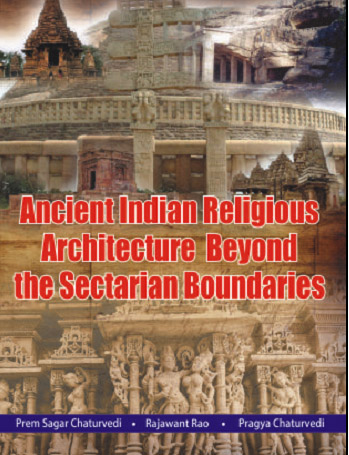 |
Binding: Hardbound, The Book: The present Volume is the latest endeavour to freshly enquire into the relevance and validity of commonly-held categorizations of ancient Indian religious architecture as Hindu, Buddhist, and Jain, often noticed in the extant standard writings on this genre of the art studies. It has been observed that while this may somehow appear true and may also have some sort of relevance primarily from the standpoint of its creators and users, who used to perform some kind of religious rites or indulged in some sorts of religious discourses and debates or even paid their obeisance to the revered deities, seated in the sanctum sanctorum, evidently to earn some spiritual merits, or, even from the perspective of its associated iconography and its lavish symbolism in its exteriors and interiors, but, viewed restrictedly from the architecture’s standpoint, these do not hold true and seem to represent only its peripheral dimensions. Architectural arrangements in these religious spaces, categorized differently, are essentially common, irrespective of their affiliations with Hindu, Buddhist and Jain, and betray the shared concepts amongst them evolved through the millenniums with very few alterations exceptionally to be called as distinct.
The Volume examines critically both the morphological and conceptual contours of these spaces right from the Vedic times to the later periods when the evolution came to its full zenith in the form of temples. How the earliest notions conceived in the making of the Yajña-vedis and chitis percolated in all the shades of later religious architecture has been explicitly elucidated. How a number of trees originally imagined as the resorts of the spirits and divinities got identified with several Hindu deities, Buddhas and the Tirthamkaras as well, and sired the notion of religious pillars to be erected in their honour as their own insignias, has all been elaborately explained to mark the conceptual and morphological affinities inherent in these so-called different religious spaces. The transformation of the rock-cut chaitya-gŗihas, slowly and gradually, into the temple architecture with many of their features not only carried forward but taken to new heights, narrate the same story. The analysis establishes that ancient Indian religious architecture is a narrative of shared concepts, of mutuality, inclusiveness, cross-connections, free exchanges of ideas and their broader adaptations, Interdependence through several points of convergences and conceptual affinities beyond the sectarian boundaries of Hindu, Buddhist and Jain. This is also endorsed by the prevalence of common terminologies - stupa, chaitya, prasada, mandira, stambha, yașți, vedikā, etc. among the Hindu, Buddhist and jain forms of architecture, their comparative importance in a particular shade notwithstanding. Thus the Volume provides a new stimulus to the students, scholars and art-historians to take the studies of ancient Indian religious architecture with a new insight and perspective which expose its overall synthesizing and overarching effect that predominantly caused its outflow and evolution in ancient India beyond the sectarian bias.
The Author: An aluminus of the University of Allahabad with meritorious academic records, Dr. Prem Sagar Chaturvedi joined the Department of Ancient History, Archaeology and Culture D. D. U. Gorakhpur University in 1972. He served this institution in several capacities and finally retired as Professor and Head on June 30, 2012. He had the chance of working both as a disciple and colleague under the sage guidance of late Professor V. S. Pathak, an eminent scholar and indologist under whose supervision he obtained Ph. D. degree for his outstanding work Some Aspects of Technology in Vedic Literature. Because of his deep understanding of literary and archaeological sources, Dr. Chaturvedi has gained expertise in several branches of historical discipline. These include Vedic and Buddhist Studies, Ancient Technologies, Art and Architecture, Archaeology and Socio-Religious studies. He is mostly known for his highly acclaimed original work, Technology in Vedic Literature in which by deft-handling of the Vedic, Avestan and Indo-European data, he has drawn the profiles of several prehistoric and protohistoric technologies, such as wood, leather, textiles, ceramics, etc. many of which being extremely fragile by nature could not be procured materially except in some very exceptional situations, and hence, hardly find any allusion in archaeological writings although most of them were synchronously practiced by the early man along with the lithic. He has discussed some more facets of technology in The Vedic Technology, a Chapter contributed to the Volume, The Dawn of Indian Civilization of PHISPC, a dream project envisioned by late Professor D. P. Chattopadhyay and in several other writings in different publications. Besides these, he has exposed quite brilliantly some basic concepts of arts and aesthetics in a number of articles contributed to various journals. He has also authored and edited the volume Archaeological Findings from the Homeland of Buddha in which major archaeological discoveries of the region traversed by Buddha have critically been analyzed and their significance has properly been exposed before the scholarly world so much so that it stands as the most updated and authentic account of the archaeological studies of the region. Dr. Chaturvedi has guided several researches on different areas of history, attended a number of national and international academic meets, delivered lectures in different academic forums and contributed more than sixty research papers in various journals and publications. At present, he is engaged as a Senior Academic Fellow with Indian Council of Historical Research, New Delhi, and is working on the Project History and Culture of Sarayūpāra Region on the Basis of Extant Archaeological Remains.
Excavations In Gujarat : Price: Rs. 2450/-, ISBN: 978-91-7320-159-2, Author: Dr. Shivananda V Rao & Dr. R. N. Kumaran, Size: 26cm, Page: 276, Illus. Year of Publication: 2015, Binding: Hardbound, This book: This book ‘Excavations in Gujarat’ gives a comprehensive history of excavated sites in Gujarat along with the material culture unearthed during excavations. These are otherwise unpublished and a many lies in the doctoral thesis of scholars that are unavailable to others. Gujarat is the only state in India where the archaeological vestiges has revealed the evidences for the First, Second and Third Urbanizations. Besides, the study of the variety of small objects from excavation has helped in understanding the life of the common people which is of enduring interest. All this had added to our knowledge and understanding of the development of the Personality of India.
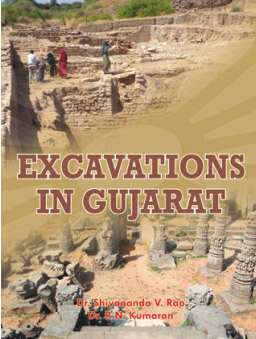 |
This Author: Dr. Shivananda V. Rao (b.1954) has worked in Archaeological Survey of India in various capacities and retired as Regional Director in 2014. He had authored and edited many books and volumes and had written number of research articles and presented papers in various National and International seminars. Dr. R. N. Kumaran (b.1975) is presently working in Archaeological Survey of India as Assistant Archaeologist. He had authored a book entitled ‘Ports and Pots in Gujarat’. He had contributed number of research articles in various journals and presented papers in various National and International seminars.
Recent Researches on Indus Civilization & Maritime Archaeology in India: Price: Rs 3,950.00, ISBN: 978-81-7320-147-9, Editors: Dr. A. S. Gaur & Sundaresh, Size: 29cm, Page: xxii+330, Illus. Col, Year of Publication: 2015, Binding: Hardbound, The Book: The Present volume comprises papers presented during the 8th Indian Conference on the Maritime Archaeology of the Indian Ocean Countries held at the National Institute of Oceanography, Goa on 1-2 July, 2013. The conference was organised by the Society for Marine Archaeology to honour the contribution made by late Dr. S. R. Rao (Founder of the Society) in the field of 'Indus Civilization' and 'Maritime Archaeology' on his birth day i. e., 1st July. The focal point of the conference was to bring together a broad spectrum of researchers working on various aspects of Harappan and Maritime Archaeology to a common scientific forum. The collection of the paper presented here is inimitable. There are new forays in many aspects of Harappan and Maritime Archaeology. The compilation will provide the reader with the latest information on the development that has taken place in these fields of research. The paper ranging from maritime Harappan, food economy, environmental studies, shipwrecks, ancient ports and scientific application for resolving archaeological problems have been included here. It is hoped that the volume will provide readers with some valuable information on the recent researches in the fields of the Indus Civilization and Maritime Archaeology.
JAIN MINORITY
RBI CREDIT Policy for Minorities -MASTER CIRCULARS
Master Circular 1. Credit Facilities to Minority Communities In terms of Reserve Bank's extant guidelines on lending to priority sector, a target of 40 per cent of Adjusted Net Bank Credit (ANBC) or Credit Equivalent amount of Off-Balance Sheet Exposures (OBE), whichever is higher, as on March 31of the previous year, has been mandated for lending to the priority sector by domestic scheduled commercial banks and foreign banks with 20 and above branches. Within this, a sub-target of 10 per cent of ANBC or Credit Equivalent amount of OBE, whichever is higher, as on March 31 of the previous year, has been mandated for lending to weaker sections which includes, among others, persons from minority communities. The Government of India has indicated that care should be taken to see that minority communities secure, in a fair and adequate measure the benefits flowing from various Government sponsored schemes. All commercial banks, have been advised to ensure smooth flow of bank credit to minority communities.
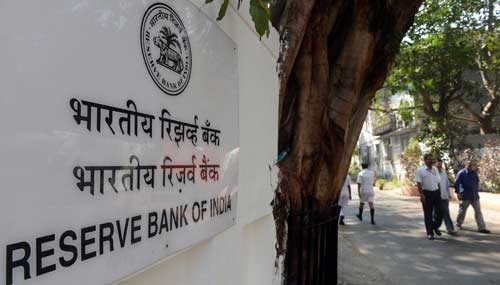 |
2. Definition of Minority Communities
2.1 The following communities have been notified as minority communities by the Government of India, Ministry of Welfare: Sikhs Muslims Christians Zoroastrians Buddhists Jains.
3. Creation of Special Cell and Designating an exclusive Officer
3.1 A Special Cell should be set up in each bank to ensure smooth flow of credit to minority communities and it should be headed by an officer holding the rank of Deputy General Manager/Assistant General Manager or any other similar rank who should function as a 'Nodal Officer'.
4 more info, RBI Link: www.rbi.org.in/Scripts RBI Master Circular- Credit Facilities to Minority Communities. Source: Sudhir Lodha, State Minorities Commission, Government of Tamil Nadu, India.
DIKSHA NEWS
JAIN DIKSHA AT BANGALORE ON THE 24th JANUARY, 2016
An aspirant for accepting diksha, Km. Sonali Bambori, Rajaji Nagar, Bangalore has decided to accept diksha in the Shwetambar Sthanakwasi sect. She has been inspired by Jain Shraman-Sanghia, Sadhwi-Ratna, Poojya Dr. Pratibha Ji maharaj. The dikhsha will be granted in the aspicious presence of Dr. Pratibha Ji maharaj. Diksha ceremony will also be attended and blessed by Sadhwi-Vrindra, Sadhwi Shri Shradha ji, Sadhwi Shri Rishita ji, Sadhwi Shri Anugya Ji and others.
SANTHARA NEWS
FEEDING LIFE INTO THE SANTHARA DEBATE
BY Akriti Gaur: While suicide is the unnatural and untimely termination of life, Santhara is the peaceful and gradual path to the extinguishing of life. It is not unnatural or sudden.
The Rajasthan High Court in a public interest litigation (Nikhil Soni v. Union of India) criminalised the ancient religious practice of the Jain community called Santhara / Sallekhana, or fast-unto-death. The court equated Santhara to “suicide” under the Indian Penal Code. This judgment has received considerable flak from the Jain community over the past few months. A special leave petition (SLP) against the order was filed in the Supreme Court by Jain groups, and the court granted an interim stay on the Rajasthan order while deciding to entertain the appeal. Following the stay, an 83-year-old woman from Tamil Nadu was recently reported to have completed the Santhara ritual and embraced death in a peaceful manner.
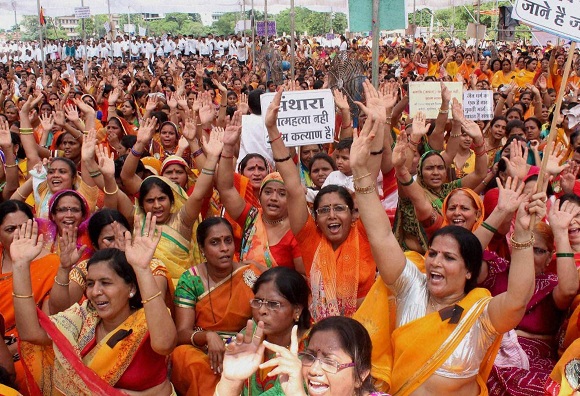 |
While the aspect of the high court ruling relating to a person’s right to religious freedom and conscience under Article 25 has been the subject of much debate and criticism, the judgment must also be critiqued in the context of the broader debate on the scope of Article 21 of the Constitution and the right to die with human dignity. The Nikhil Soni judgment not only affects a religious group’s freedoms guaranteed in the Constitution, but also has a deep bearing on the ongoing debate on the right to die with dignity. While the Supreme Court is yet to decide on the matter, it is important to analyse the infirmities in the high court judgment, which misconstrues certain Supreme Court rulings and seems to have taken the unsettled legal position on Article 21 at face value, without adequately analysing precedent.
Article 21 guarantees all citizens the inalienable and vital right to life. Admittedly, an alteration affecting human life, or placing this right in jeopardy must call for a thorough and critical judicial scrutiny. The Supreme Court, in the case of Gian Kaur v. State of Punjab has held that the “right to life” does not include the “right to die. The “right to die with dignity”, however has been construed to fall within the ambit of Article 21. The Rajasthan high court has not taken sufficient note of the fact that the Supreme Court, in Aruna Ramchandra Shanbaug V. Union of India (2011), states that if a person consciously and voluntarily refuses to take lifesaving medical treatment, it is not a crime. It permits passive euthanasia in certain rare situations. In the absence of clear statutory guidelines, the court has laid down extensive guidelines and safeguards for an individual who may want to discontinue/withdraw life support (involuntary passive euthanasia). While the question of the harmonious interpretation of the Aruna Shanbaug and Gian Kaur judgments is pending before the Supreme Court, the question of whether not taking food consciously and voluntarily with the aim of ending one’s life is a crime under section 309 of the IPC (attempt to commit suicide) was not firmly decided in either case.
On the other hand, the Supreme Court in Aruna Shanbaug has upheld the right to bodily autonomy of an individual–an important point of consideration when it comes to the legality of a fast-unto-death. The gaping hole in the Rajasthan high court’s reasoning on the protection granted by Article 21 therefore lies in its misinterpretation of judicial precedent. The Gian Kaur verdict has held that the “right to live with dignity” includes the “right to die with dignity”, where the process of natural death is merely being accelerated to its conclusion. It must be added here that this matter, heavily relied on by both the parties, primarily dealt with the criminalisation of suicide, i.e. unnaturally ending one’s life. The right to die with dignity at the end of one’s life has been distinguished from suicide, and should have been taken note of by the high court in Nikhil Soni. The court further interprets the decisions in Gian Kaur and Aruna Shanbaug to mean that “no person has a right to take his own life consciously, as the right to life does not include the right to end the life voluntarily”. However, as pointed above, both these cases have dealt with unnatural and sudden extinguishment of life. Curiously, the court in the Nikhil Soni judgment also admits that in both these cases, “the debate of voluntary death by a peaceful method was left inconclusive.”
Ancient practices and ancient laws: Article 21 as interpreted by the Supreme Court includes the right to live with dignity. The aspects of this right can also be located in the Directive Principles of State Policy and more visibly in the Preamble to the Constitution which “assures dignity of the individual”. It was observed by the Supreme Court in the case of Maneka Gandhi v. Union of India (1978) that this fundamental right epitomizes the basic values cherished by citizens of our country since Vedic times. These values not only protect the dignity of the individual but also foster conditions suitable for every human being to nurture her personality to the best extent possible. In the Nikhil Soni case, the petitioners argued that fasting until death is primarily a tool of self-destruction, it is an ancient practice that doesn’t fit into modern thinking - that even if this is backed by faith or belief, this act is of a criminal nature and cannot be protected by the fundamental right to freedom of religion as it is a threat to public order, morality and health. The case of Santhara is a unique one. It has opened up a long-drawn debate on the right to die with dignity, raising complex philosophical and legal question of state interference in an individual’s right to bodily autonomy.
Santhara is not suicide: In the Nikhil Soni case, members of the Jain community argued that the intention of the individual in taking up Santhara is not to give up life but to take death in its own stride. It has been described as a peaceful and voluntary path to salvation taken up by an individual at a stage in her life, where it becomes difficult to lead a normal existence, owing to illness, unavoidable natural calamity, incurable disease or old age. The manner in which suicide is committed can be distinguished from Santhara. While suicide is the unnatural and untimely termination of life, Santhara is the peaceful and gradual path to the extinguishing of life. It is not unnatural or sudden. More importantly, it is a means to achieve the ultimate end to one’s life by giving up food, water, passions, desires and material belongings in order to accelerate the dying process, which has already begun in the body. The individual also has the option of pulling out from this process as and when she chooses to. The road ahead for the Supreme Court: The right of a dying person to die with dignity when her life is ebbing out has been judicially recognized in Gian Kaur and Aruna Shanbaug. These judgments have unfortunately been read out of context by the high court. The court equated Santhara to assisted suicide and justifies its illegality by concluding that the “right to die” is not included in the ambit of “right to life” as guaranteed by Article 21. The crucial “right to die with dignity” has not found any mention in the court’s reasoning. The judgment seems to suggest that there is no dignity in fasting, and that the right to die with dignity does not take into account a person’s ethical, spiritual and religious considerations.
While this debate remains inconclusive at present, the high court has gone a step backward by using the existing legal stance, or rather the lack thereof as a straight jacketed formula to criminalise an established practice of an entire religious group. It is now left to the Supreme Court to examine this practice in depth not only within the scope of Article 25 protections but also to carefully evaluate it as per the principle of the “right to die with dignity” guaranteed under Article 21. The question on voluntary death by peaceful means, which was left unanswered in Aruna Shanbaug needs to be scrutinised in order to deliver a final ruling on Santhara’s legality. Akriti Gaur is a Junior Research Fellow at the Vidhi Centre for Legal Policy. Alok Prasanna Kumar provided inputs for this article.
JAIN PRIEST UNDERTAKING SANTHARA PASSES AWAY
Jaipur: 28th October, 2015: A 92-year-old Jain priest, Sadhvi Rai Kumari, passed away in Jodhpur on 28th October, 2015 after initiating the Jain ritual of Santhara 16 days ago. “Even at 92, she was very much conscious and had decided to undertake Santhara in a chetan awastha (with a conscious mind).
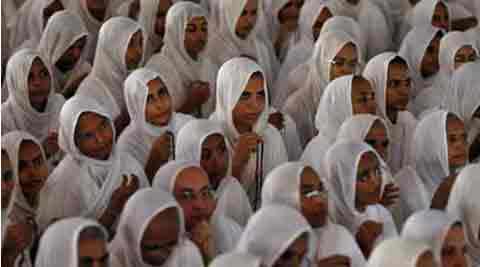 |
In the words of Sadhvi Chandan Prabhaji, who had been with Sadhvi Rai at Jodhpur’s Padmavati Teerth in Salawas for the past 37 years, the passing away of her divine soul is a miracle for us. I have never witnessed such a divine act: she first calculated her time through jyotish (astrology/soothsaying) to leave the body and then left exactly at the right moment.”
Padmavati Teerth’s Chief Patron Pradeep Kant said that Sadhvi Rai never used a vehicle and had travelled over a lakh kilometres “from Kashmir to Kanyakumari” on foot ever since she had taken ‘deeksha’ at the age of 11. For 80 years she touched many lives and was also a great scholar of Sanskrit, mathematics as well as astrology. She was also known as a Shatavdhani-one who solves a 100 questions simultaneously.
On August 10, the Rajasthan High Court banned Santhara and made it an offence under Section 309 (attempt to suicide) of the Indian Penal Code. It held that any person supporting the practice would be prosecuted for abetting suicide. However, the Supreme Court on August 31 stayed the high court order. She became the second person undertaking Santhara to pass away in the state since the Supreme Court stayed a Rajasthan High court order declaring the ritual a penal offence.
TAMILNADU JAIN WOMAN EMBRACED DEATH AFTER SANTHARA
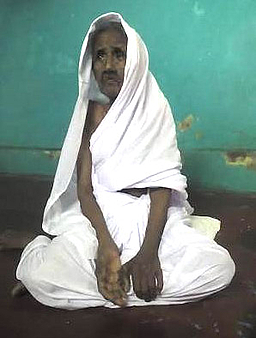 |
Chennai: 5th November, 2015: Marudevi Ammal, 83, after observing 41 days santhara (sallekhana) embraced death. Marudevi took the sallekhana vow 40 days ago.
In the days since then, she gradually reduced the food and water she had. Ten days before the end, she gave up food and water completely, and remained in a meditative state. Marudevi decided to end her life according to Jain customs after the Supreme Court on August 31 stayed a Rajasthan high court order that declared santhara as a penal offence.
According to the community, this could be the first time a woman is embracing santhana in Tamil Nadu. "We believe Marudevi is the first woman to take santhara in the state," Chennai-based Jain scholar K Ajithadoss said.
"There is an inscription in Vijayamangalam about a santhara by Chamundaraya's sister, but there is no firm evidence. Chamundaraya was a brave and celebrated general of the Ganga kings who played an important role in the history of Shravanahelagola." Marudevi has taken the vow voluntarily, said S Jeeva Kumar, a priest in a Jain temple in Kancheepuram. Inscriptions in Tamil Brahmi dating back to 5th century AD found at Tirunatharkundru in Villupuram record the death of ascetic Chandranandhi who undertook santhara and fasted for 57 days till his death.
A 10th century AD inscription on a hillock in the same place records the death of Ilayaparadarar who fasted for 30 days. Santhara is a highly respected practice in Jain ritualism. It is believed that this practice leads an individual to a world of non-violence after rejecting all desires in the material world. Ascetics normally take the santhara vow.
JAIN CALENDAR - NOVEMBER 2015
VIR SAMVAT 2541| 2542 JAIN CALENDAR VIKRAM SAMVAT 2071 / 2072
Aatham| Chaudas | Pancham | Bij | Agiyaras | JainFestival | Auspicious Day |
AASO - NOVEMBER 2015 - KARTIK | ||||||
| Mon | Tue | Wed | Thu | Fri | Sat | Sun |
| 30 Vad Pancham | AASO: 1 TO 11 NOVEMBER | 1 Vad Chhath | ||||
| 2 Vad Satam | 3 Vad Aatham | 4 Vad Nom | 5 Vad Nom | 6 Vad Dasam | 7 Vad Agiyaras | 8 Vad Baras |
| 9 Vad Teras | 10 Vad Chaudas | 11 Vad Amas | 12 Sud Ekam | 13 Sud Bij | 14 Sud Trij | 15 Sud Choth |
| 16 Sud Pancham | 17 Sud Chhath | 18 Sud Satam | 19 Sud Aatham | 20 Sud Nom | 21 Sud Dasam | 22 Sud Agiyaras |
| 23 Sud Baras | 24 Sud Teras | 25 Sud Chaudas | Poonam | 26 Vad Ekam | 27 Vad Bij | 28 Vad Trij | 29 Vad Choth |
AVOID GREEN & ROOT VEGETABLES AVOID ROOT VEGETABLES JAIN FESTIVAL AUSPICIOUS DAY OTHER: |

